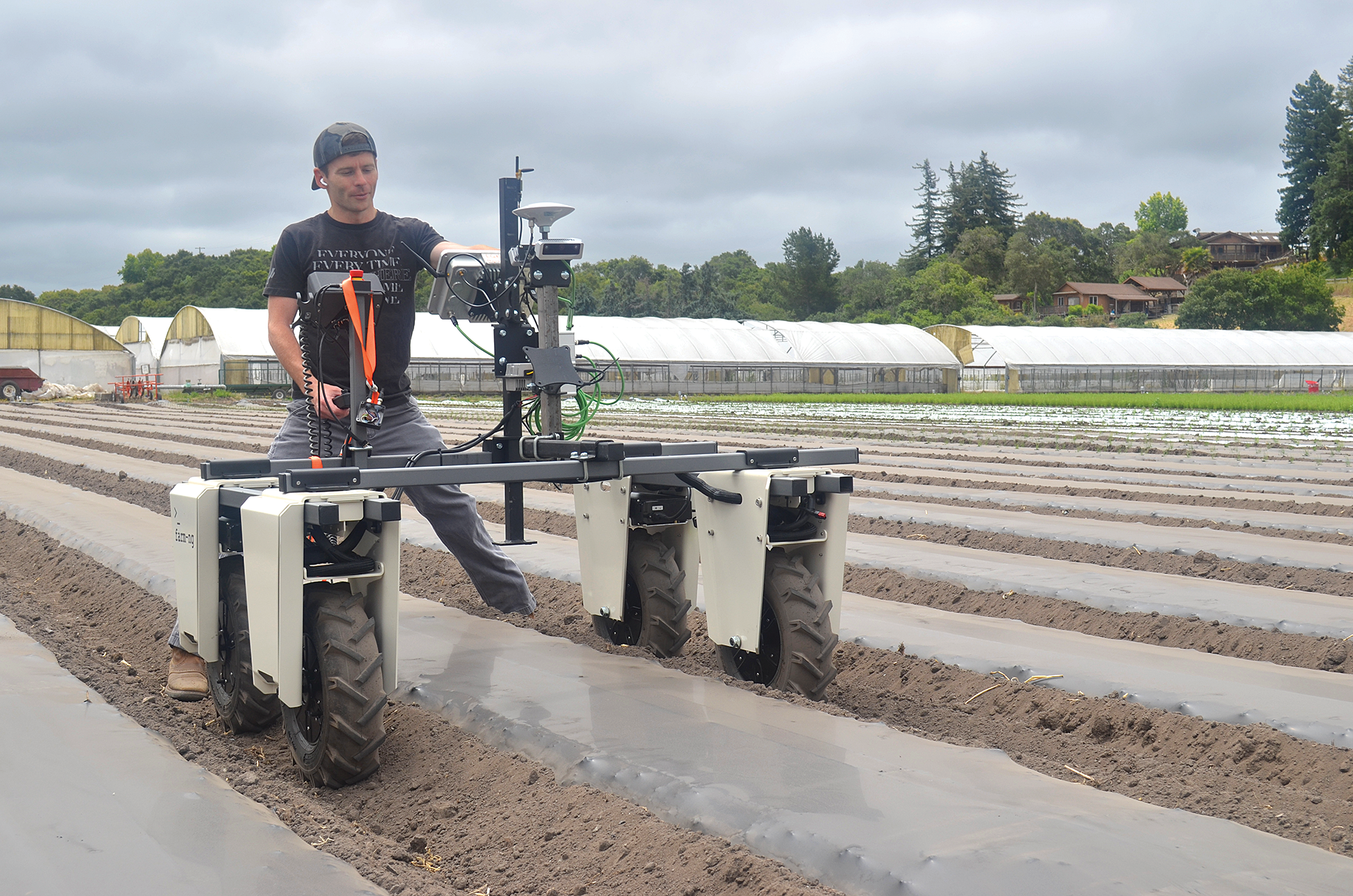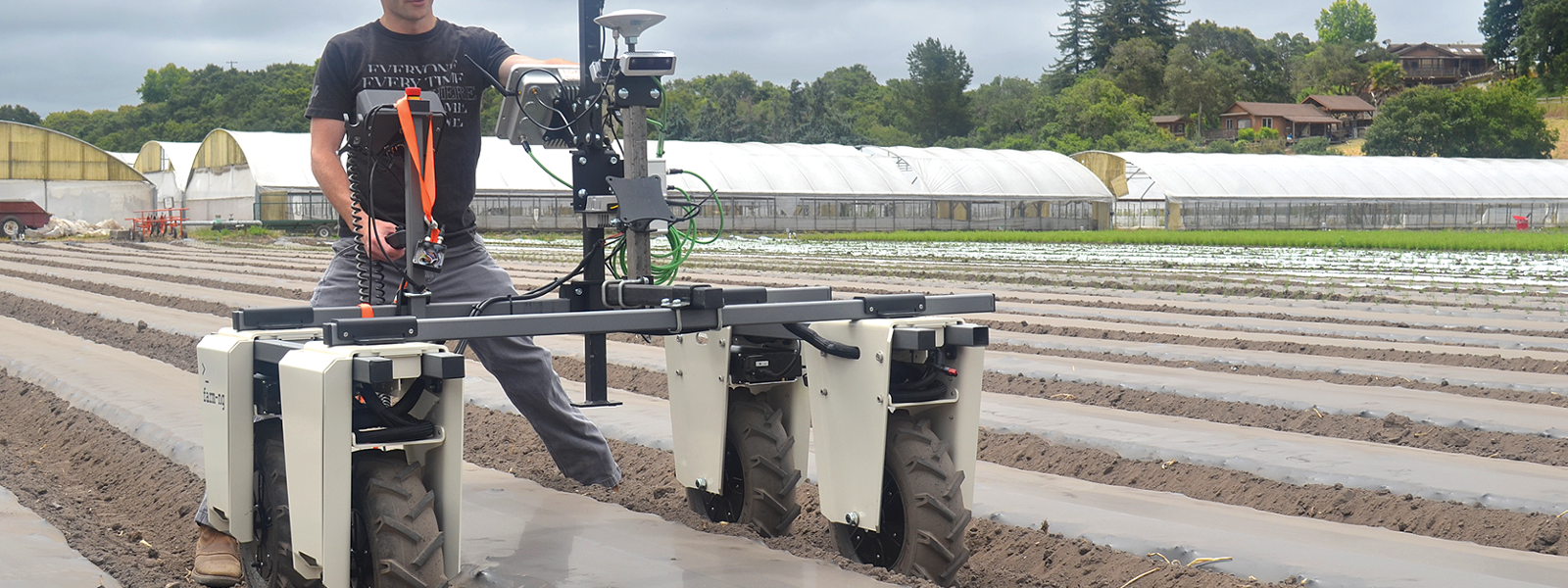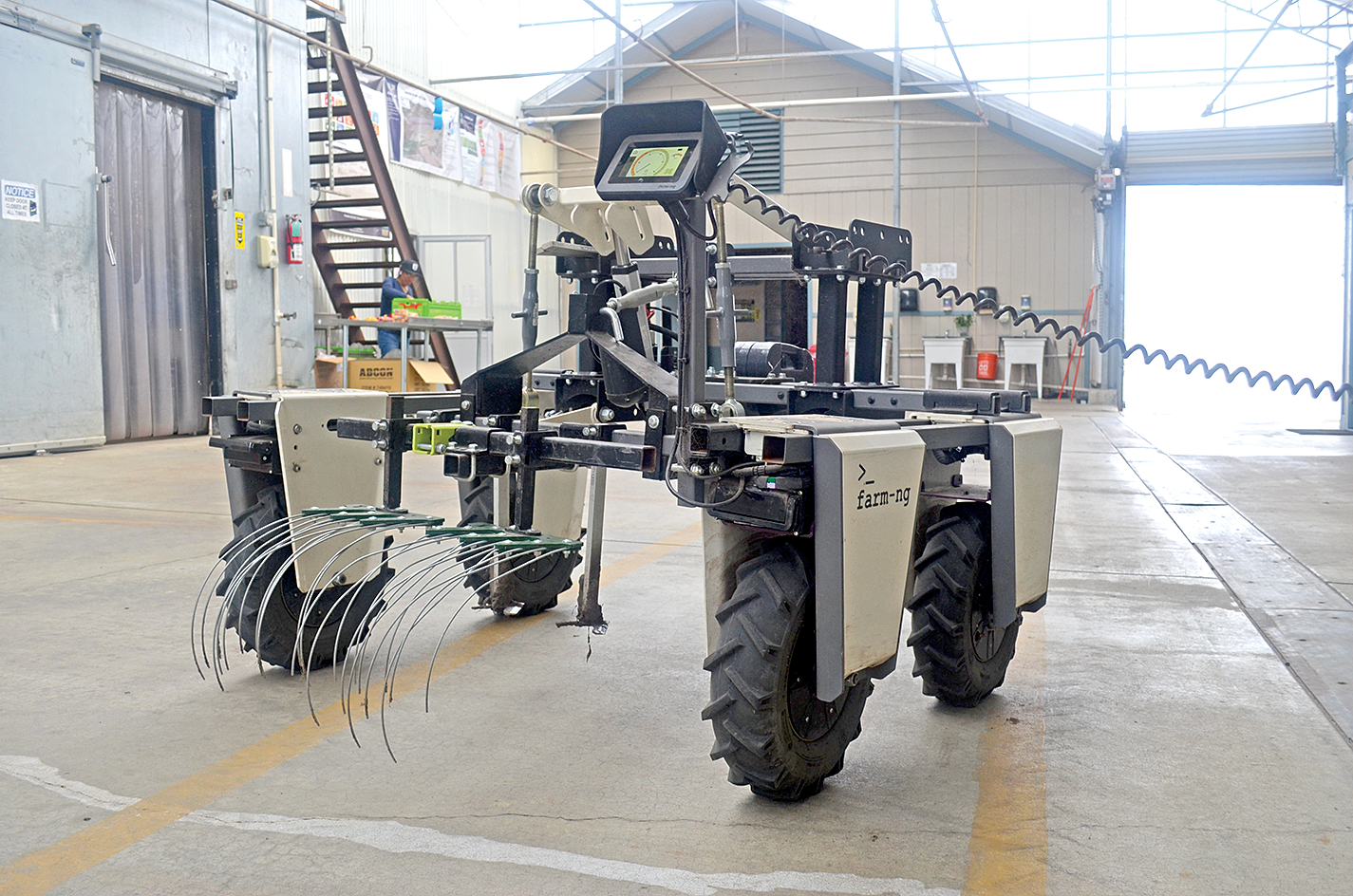Silicon Valley meets Salinas Valley through ag tech

Wren Ramsey, a “robot wrangler” for the Salinas Valley agricultural tech firm farm-ng, monitors the company’s farming robot, the Amiga, at Jacobs Farm del Cabo in Watsonville. The firm is among several tech startups drawn to the vegetable-growing region.
Photo/Caitlin Fillmore


Photo/Caitlin Fillmore
By Caitlin Fillmore
Eight units in a warehouse space near the Watsonville airport hummed with life as welders in another room fabricated steel tube frames. A few doors down, a group assembled and prepared to flush some “brains.”
These brains power farm-ng, an agriculture technology company that located its manufacturing center in Watsonville to work with farmers in the Salinas Valley vegetable-growing region. As autonomous solutions pick up steam across the agriculture sector, farm-ng has carved a niche with its farming robot, the Amiga. In the process, the company says it hopes to “democratize access” in the food system.
“If we can create innovations to make small farms more economically viable, we can create farmers,” said Nathan Dorn, business development manager at farm-ng. Dorn called the company a “rapid prototyping shop” because farm-ng specializes in a robot that begins as an unadorned square frame with four wheels. From there, Amiga owners decide how to use the battery-powered robot to help lift, pull or otherwise solve time-consuming challenges on the farm.
The firm is among several agricultural tech startups moving to the Salinas Valley, home to the Western Growers Center for Innovation and Technology, which supports companies that develop robotics that help farmers often facing worker shortages to harvest crops, control weeds and more.
Some area growers are already employing its $13,000, 320-pound Amiga platform, which offers a customizable, automated system for those looking for assistance with manual labor tasks. Instead of spreading compost with a wheelbarrow, the Amiga can affix farm-ng’s “integrated compost spreader assembly” kit and roll along on cruise control.
The limited capacity of a backpack-mounted sprayer can be replaced by a larger tank resting on the Amiga, which can carry up to 1,000 pounds, according to farm-ng. Farmers can also purchase kits from the company for implements such as seeders and finger weeders.
“(The technology) is practical to improve people’s lives now. It’s applicable now,” said Ethan Rublee, who founded farm-ng in 2020.
The term “ng” is commonly used in computer programming language to represent the idea of the “next generation” always on the horizon.
“We see customers using (the Amiga) in ways we hadn’t thought,” Rublee added.
Rublee was also founder and chief technology officer of Arraiy Inc., a Palo Alto artificial intelligence and machine-learning firm with clients in the motion picture and video game industries. Now, in his new venture, he is marketing farming robots.
The Amiga’s brains are contained in a 4.3-inch rectangular touchscreen, similar to a modern car’s infotainment system. Two cameras operate farm-ng’s proprietary “vision navigation” system, technology that will also be used to land the Blue Ghost spacecraft on the moon next year. The screen mounts to a “tractor communication backbone.”
Researchers at the University of California, Santa Cruz, and at UC Agriculture and Natural Resources outfitted the Amiga with robot arms capable of squishing invasive moths. Another customer transformed hand-weeding operations to the Amiga, which tripled productivity, Dorn said.
In the past two years of sales for the Amiga, 100 robots have helped a variety of farmers achieve multiple tasks in places including Napa Valley and with new landscapes and crops in Iowa and Pennsylvania. Watsonville farmer Larry Jacobs of Jacobs Farm del Cabo was the first Amiga customer.
Today, Jacobs uses a fleet of Amigas to move harvested herbs, flowers, tomatoes, squash and other vegetables out of the fields and greenhouses of his organic farm.
Jacobs Farm del Cabo farms nearly 5,000 acres between Watsonville and the Baja California peninsula of Mexico. Amigas assist in bed mulching with compost, cultivating, vacuuming insects, transporting trash cans to the dumpster and flaming weeds as they emerge, Jacobs said.
“It’s not a replacement for a tractor but does a lot of the light work with minimum soil compaction, quietly, and is easily operated,” said Jacobs, who rotates seven robots around his Watsonville farm.
Jacobs has been following the evolution of robotics in agriculture since 2015 and said he believes the technology will define the future of farming.
“Tomorrow’s farm will be dependent on autonomous tools integrated with data collection to make smarter and more precise decisions,” he said. “Change is being driven by growing labor restraints and increasing costs of living that mandates higher incomes for individuals dedicated to growing the food we eat.”
Rublee, who describes himself as a “serial roboticist and entrepreneur,” said he envisions farm-ng as a tool to stabilize the feasibility of small farms. He pitches the Amiga as a lighter, lower-cost alternative to some imposing high-tech harvesters and weeders that can stand 8 feet tall and can carry a hefty price tag.
“I’m excited to be the outlier,” Rublee said. “It gives us a space to play.”
He said part of farm-ng’s business model is collaborating with farmers who need help purchasing an Amiga. Rublee said he helps farmers connect with Central Coast Community Energy’s Ag Electrification Program. The community-owned electricity provider offers rebates to customers who replace fossil fuel powered agricultural equipment with new, all-electric equipment, according to its website.
As to what inspired his engineering aspirations and move to agricultural robotics, Rublee said, “I worry about the next food system.”
“Agriculture is a large part of the solution,” he added. “I’m thinking of the next generation of technology to grow our food that enables communities instead of displacing them. It’s the world we’d like to see.”
(Caitlin Fillmore is a reporter in Monterey County. She may be contacted at cslhfillmore@gmail.com.)




